Key Takeaways:
- Tinted moisturizers combine skincare and light coverage in one step
- They’re perfect for achieving that natural “no-makeup makeup” look
- The best tinted moisturizers contain SPF and skin-nourishing ingredients
- Application techniques vary depending on your desired coverage
- Choose formulas based on your skin type: dewy for dry skin, oil-free for oily skin
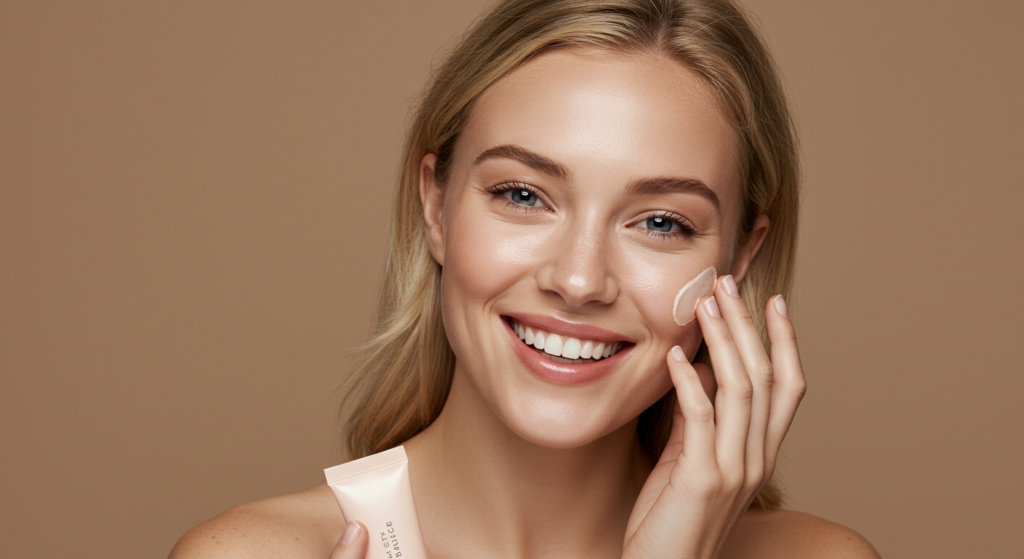
Let’s face it—sometimes you want to even out your skin tone without piling on heavy foundation. That’s exactly where tinted moisturizers come into play. These multi-tasking products have revolutionized the beauty world by bridging the gap between skincare and makeup. They give you that perfect “my skin but better” look while actually improving your complexion over time.
I’ve tested dozens of tinted moisturizers over the years and spoken with countless makeup artists about their techniques. What I’ve found is that the right tinted moisturizer—along with proper application—can transform your everyday beauty routine into something effortless yet polished.
Whether you’re rushing out the door on a busy morning or creating a minimal makeup look for summer, tinted moisturizer deserves a prime spot in your beauty arsenal. Let’s dive into everything you need to know about this game-changing product.
What Is Tinted Moisturizer (And Why It’s Different From BB Creams)

Tinted moisturizers are exactly what they sound like—moisturizers with a hint of color. But there’s more to them than meets the eye.
The Basics of Tinted Moisturizer
At its core, a tinted moisturizer is a skincare-makeup hybrid. Unlike traditional foundations, which focus primarily on coverage, tinted moisturizers prioritize hydration while adding a sheer wash of color. They typically offer light coverage that evens out minor discoloration and adds a healthy glow to the skin.
Most quality tinted moisturizers contain ingredients like hyaluronic acid, vitamins, and antioxidants that benefit your skin throughout the day. Think of them as skincare products that happen to make you look better instantly.
Tinted Moisturizer vs. BB Cream vs. CC Cream
The beauty world loves its alphabet creams, but each serves a different purpose:
| Product | Primary Focus | Coverage | Added Benefits |
|---|---|---|---|
| Tinted Moisturizer | Hydration | Light | Basic sun protection |
| BB Cream | All-in-one | Light-medium | Priming, brightening |
| CC Cream | Color correction | Medium | Targets redness/discoloration |
Tinted moisturizers typically offer the lightest coverage of the three. BB (Beauty Balm) creams provide slightly more coverage plus priming benefits, while CC (Color Correcting) creams focus on neutralizing specific skin issues like redness or sallowness.
Who Benefits Most From Tinted Moisturizer
Tinted moisturizers work wonderfully for:
- People with mostly clear skin who want minimal coverage
- Dry skin types needing extra hydration
- Those who prefer a natural, dewy finish
- Makeup minimalists who value quick application
- Anyone who wants their makeup to enhance rather than mask their skin
The Skincare Benefits Hidden in Your Tinted Moisturizer
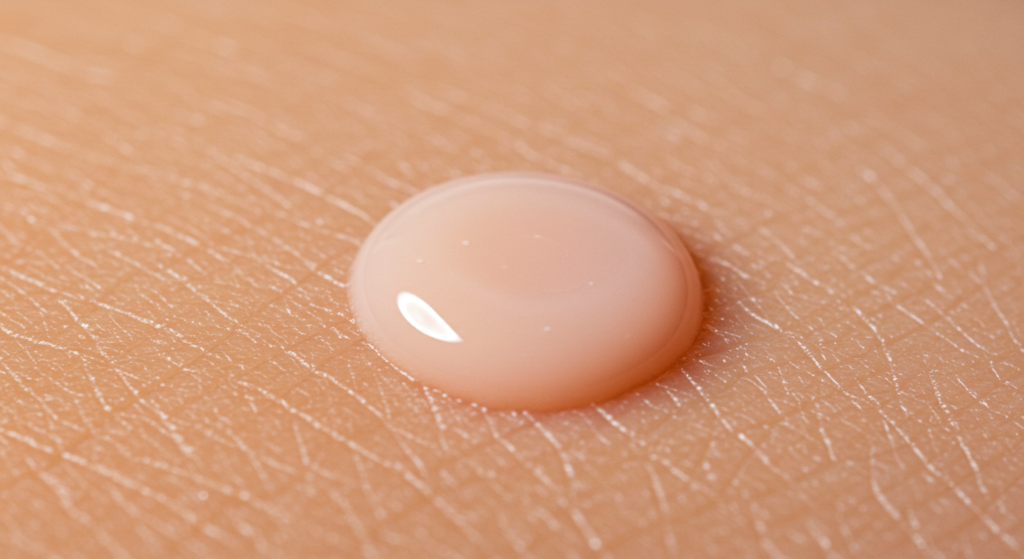
Beyond the instant gratification of evening out your skin tone, quality tinted moisturizers work overtime to improve your complexion.
Hydration Heroes: Key Moisturizing Ingredients
The best tinted moisturizers contain ingredients that lock in moisture and strengthen your skin barrier:
- Hyaluronic acid: Holds up to 1000x its weight in water, plumping skin from within
- Glycerin: Draws moisture from the air into your skin
- Squalane: Mimics your skin’s natural oils for balanced hydration
- Ceramides: Help rebuild and reinforce your skin’s protective barrier
When these ingredients are combined with tint, you’re essentially treating your skin while perfecting its appearance—multitasking at its finest.
Sun Protection Factors: The SPF Breakdown
Many tinted moisturizers come with built-in SPF, typically ranging from 15 to 50. This added protection is convenient but comes with some caveats:
- Most dermatologists recommend using a separate sunscreen under your tinted moisturizer
- You would need to apply approximately a quarter-sized amount of product to get the labeled SPF protection
- Chemical vs. mineral SPF in tinted moisturizers affects both skin sensitivity and finish
Products with zinc oxide or titanium dioxide (mineral SPF) tend to be better for sensitive skin but may leave a slight white cast on deeper skin tones.
Anti-Aging and Skin-Repairing Ingredients
Look for these powerhouse additions in your tinted moisturizer:
- Niacinamide: Reduces pore appearance and evens skin tone
- Vitamin C: Brightens and protects against environmental damage
- Peptides: Signal skin to produce more collagen
- Plant extracts: Provide antioxidant protection against free radicals
These ingredients work beneath the surface while the tint creates immediate improvements—it’s like getting a treatment and makeup in one tube.
How to Choose the Perfect Tinted Moisturizer for Your Skin Type
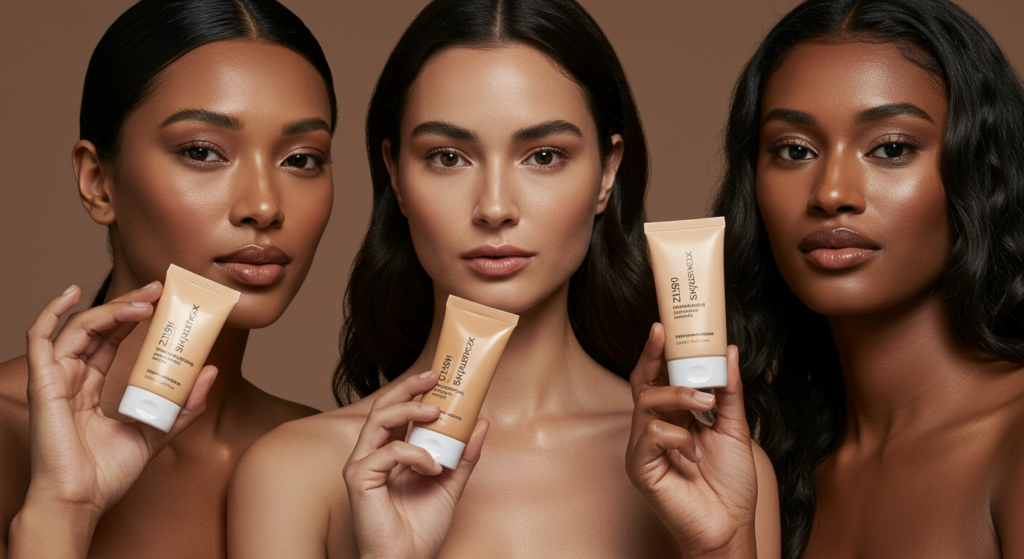
Dry Skin Saviors: Ingredients to Look For
If your skin feels tight or flaky, seek out these hydration boosters:
- Hyaluronic acid or sodium hyaluronate
- Shea butter or plant oils
- Ceramides
- Glycerin
- Squalane
Avoid alcohol-heavy formulas, which can further dehydrate your skin. Opt for products labeled “dewy,” “hydrating,” or “luminous” for the most skin-quenching benefits.
Oily and Combination Skin: Balancing Coverage and Shine
For skin that produces excess oil, look for:
- Oil-free or oil-controlling formulas
- Non-comedogenic claims (won’t clog pores)
- Mattifying ingredients like silica
- Salicylic acid or niacinamide to manage breakouts
- Terms like “oil-control” or “matte finish”
The right tinted moisturizer can help control shine without stripping your skin or causing rebound oil production.
Sensitive and Acne-Prone Skin: Gentle Yet Effective Options
If your skin is reactive or breakout-prone, prioritize:
- Fragrance-free formulations
- Mineral-based SPF (zinc oxide/titanium dioxide)
- Soothing ingredients like aloe vera or centella asiatica
- Non-comedogenic formulas
- Products free from common irritants like essential oils
Remember that fewer ingredients often means less chance of irritation—simplicity can be your friend.
Finding Your Perfect Shade Match: Beyond Light, Medium, and Dark

The limited shade ranges of tinted moisturizers have historically been their biggest downfall. Thankfully, many brands have expanded their offerings.
Understanding Undertones in Tinted Moisturizers
Your perfect shade match depends not just on depth but also undertone:
- Warm undertones: Yellow, golden, or peachy bases
- Cool undertones: Pink, red, or bluish bases
- Neutral undertones: Balanced between warm and cool
- Olive undertones: Greenish or grayish bases
When testing shades, check how they look on your jawline in natural light. The right shade should seem to disappear into your skin.
Shade-Adjusting Techniques for Better Matches
If you can’t find your exact match:
- Mix two shades to customize your perfect color
- Add a drop of facial oil to sheer out coverage
- Use color-adjusting drops to modify undertones
- Apply bronzer strategically if the shade is slightly too light
Remember that tinted moisturizers are forgiving by nature—their sheerness means perfect matching is less crucial than with full-coverage foundation.
Inclusive Brands Leading the Shade Revolution
These brands have made strides in offering diverse shade ranges:
- NARS Pure Radiant Tinted Moisturizer (20 shades)
- Fenty Skin Eaze Drop Blurring Skin Tint (25 shades)
- Laura Mercier Tinted Moisturizer (20 shades)
- Tower 28 SunnyDays SPF 30 Tinted Sunscreen Foundation (14 thoughtfully developed shades)
Support brands that recognize beauty comes in more than just a handful of shades.
Application Techniques: The Pro Methods for Flawless Finish

How you apply tinted moisturizer significantly impacts the final result.
Tools of the Trade: Fingers vs. Brushes vs. Sponges
Each application method offers different benefits:
- Fingers: Warms the product for better blending; provides light, natural coverage; ideal for dry skin
- Synthetic foundation brush: Gives more precision and slightly fuller coverage; good for targeting specific areas
- Damp makeup sponge: Creates an airbrushed finish; helps sheer out product for the most natural look
Try different methods to see which gives you your preferred finish—or use a combination for customized coverage.
Step-by-Step Application for Natural-Looking Skin
Follow this foolproof method for perfect application:
- Start with clean, moisturized skin (allow skincare to fully absorb first)
- Apply a pea-sized amount of tinted moisturizer to your fingertips
- Begin at the center of your face, blending outward in gentle, circular motions
- Use slightly less product around the hairline and jawline to avoid obvious edges
- Add a tiny bit more to areas needing extra coverage (usually around the nose or cheeks)
- Let the product settle for 1-2 minutes before evaluating if you need more coverage
This gradual building approach prevents the cakey look that can happen when you apply too much at once.
Layering and Coverage-Building for Problem Areas
For areas that need extra help:
- Apply a small dot of concealer before your tinted moisturizer for major discoloration
- Use a clean finger to tap additional tinted moisturizer just on spots needing more coverage
- Try the “spot foundation” technique—use actual foundation just on areas needing serious coverage
- Set areas prone to fading with a light dusting of translucent powder
These targeted techniques maintain the natural look of tinted moisturizer while addressing specific concerns.
Beyond Basic: Customizing Your Tinted Moisturizer Experience
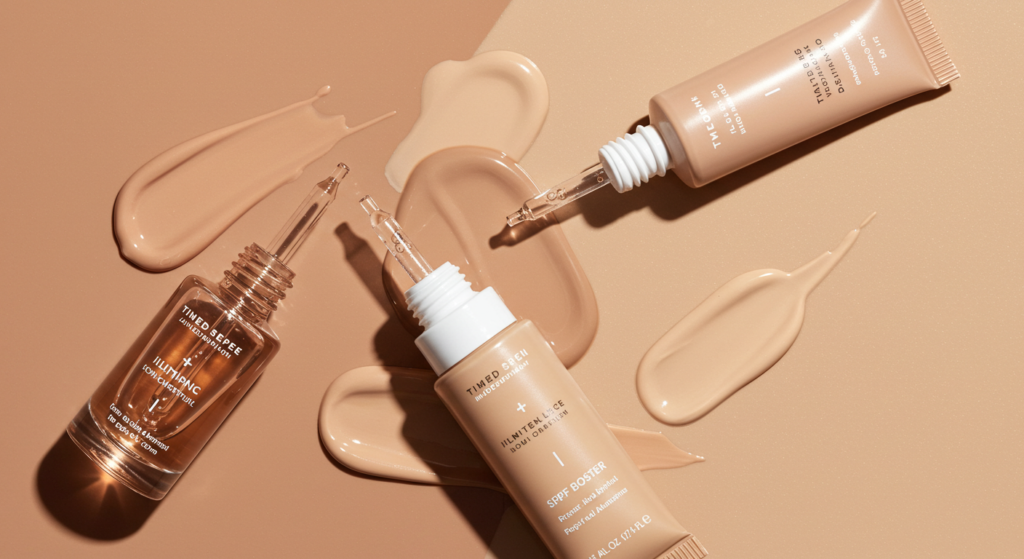
Take your tinted moisturizer to the next level with these professional tweaks.
Mixing Custom Formulas: Boosters and Add-Ins
Create your perfect product by mixing in:
- Liquid illuminator for an all-over glow
- Color-correcting drops to neutralize discoloration
- Facial oil for extra hydration
- SPF booster for increased sun protection
- A drop of foundation for more coverage
Start with small amounts—a single drop can significantly change the formula.
Seasonal Adjustments for Year-Round Perfection
Adapt your tinted moisturizer routine throughout the year:
- Summer: Choose higher SPF, possibly a more matte finish
- Winter: Mix with a drop of face oil for extra moisture
- Fall/Spring: The standard formula usually works well, adjust as needed for humidity changes
You might need two different shades to accommodate seasonal skin tone changes.
Pro Makeup Artist Tricks for Red Carpet Results
These insider techniques elevate your tinted moisturizer game:
- Apply with a damp sponge, then press a clean sponge over skin to remove excess
- Use a setting spray instead of powder to maintain dewiness while extending wear
- Mix with liquid highlighter for an all-over lit-from-within glow
- Apply an extra layer just on cheekbones for a natural-looking contour
- Spritz face with water after application, then gently press with a tissue for a skin-like finish
These methods create that coveted “expensive skin” look that appears effortless.
Troubleshooting Common Tinted Moisturizer Problems
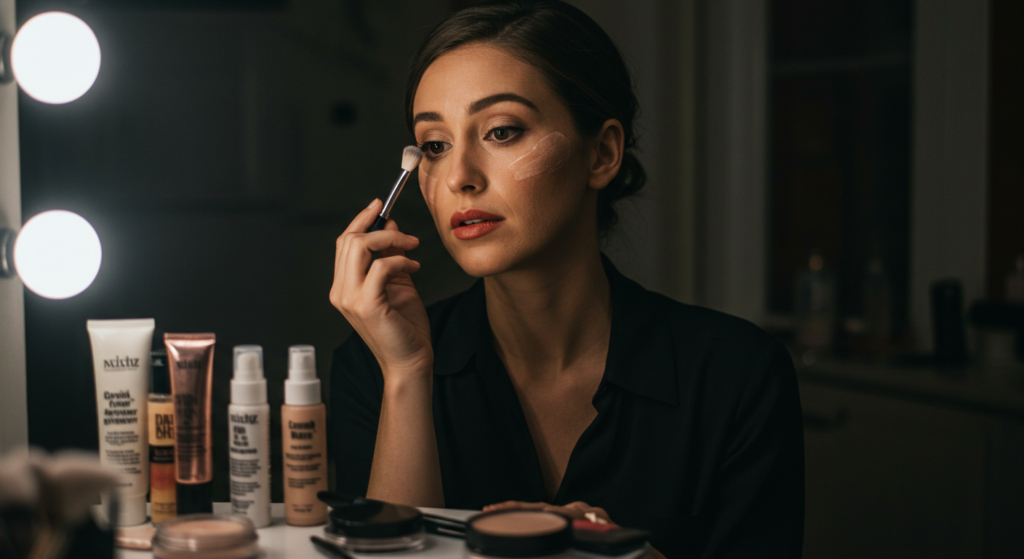
Even this user-friendly product can sometimes misbehave.
Dealing With Patchiness and Uneven Application
If your tinted moisturizer applies unevenly:
- Exfoliate regularly to remove dead skin cells that cause patchiness
- Apply a hydrating primer before tinted moisturizer
- Try a different application tool—sometimes fingers work better than brushes
- Make sure your skincare has fully absorbed before applying
- Consider if your skin type matches the formula (dewy for dry skin, matte for oily)
Proper skin prep makes all the difference in how tinted moisturizer sits on the skin.
Extending Wear Time: Tips for Long-Lasting Coverage
Make your tinted moisturizer last all day with these tricks:
- Apply a gripping primer designed for minimal makeup
- Set strategic areas (T-zone, under eyes) with a light dusting of powder
- Carry blotting papers to remove oil without disturbing makeup
- Try a makeup setting spray formulated for natural looks
- Touch up with a beauty sponge loaded with a tiny bit more product instead of adding powder
These techniques preserve the fresh, skin-like quality while improving longevity.
Fixing Oxidation and Color-Changing Issues
If your tinted moisturizer turns orange or darker throughout the day:
- Choose a shade slightly lighter than you think you need
- Look for formulas without iron oxides (the main culprit in oxidation)
- Apply a primer with antioxidants to create a barrier between your skin oils and the makeup
- Set immediately with translucent powder to “lock” the color
- Consider your skincare—some vitamin C products can increase oxidation
Testing wear time before an important event helps avoid unexpected color changes.
The Best Tinted Moisturizers for Every Budget

Quality options exist at every price point.
Luxe Picks Worth the Splurge
These high-end options deliver exceptional results:
- Chantecaille Just Skin Tinted Moisturizer ($79): Beautiful skin-like finish with anti-pollution protection
- La Mer The Radiant SkinTint SPF 30 ($100): Luxurious hydration with marine ingredients
- Sisley Phyto-Hydra Teint ($122): Botanical-infused formula that improves skin over time
- Tom Ford Soleil Glow Tinted Moisturizer ($120): Luminous finish with surprising coverage
Luxury tinted moisturizers typically offer better-for-skin ingredients and more sophisticated finishes.
Mid-Range Heroes That Deliver
These reliable options offer excellent quality:
- Laura Mercier Tinted Moisturizer Natural Skin Perfector ($48): The original cult favorite with vitamin E
- NARS Pure Radiant Tinted Moisturizer ($45): Oil-free formula with vitamin C
- Ilia Super Serum Skin Tint SPF 40 ($48): Skincare-forward with hyaluronic acid and niacinamide
- Kosas Tinted Face Oil ($42): Innovative oil formula for dry skin
These products have stood the test of time with loyal followings.
Budget-Friendly Options That Outperform Their Price Tag
These affordable finds deliver impressive results:
- Neutrogena Healthy Skin Glow Sheers ($14): Antioxidant-rich with vitamin E
- Wet n Wild Bare Focus Tinted Hydrator ($7): Hyaluronic acid-infused with natural finish
- ColourPop Pretty Fresh Hyaluronic Tinted Moisturizer ($14): Impressive shade range with coconut water
- The Ordinary Serum Foundation ($7): More coverage than typical tinted moisturizers but similarly lightweight
Don’t assume higher price means better performance—these budget picks often outshine luxury options.
Makeup Artist-Approved Looks Using Tinted Moisturizer as a Base

Build complete looks around your tinted moisturizer foundation.
Quick 5-Minute Fresh Face
For days when you’re short on time:
- Apply tinted moisturizer all over with fingers
- Dab cream blush on cheeks and blend
- Swipe tinted lip balm on lips
- Curl lashes and add minimal mascara
- Brush brows up with clear gel
This routine takes literally five minutes but makes you look polished and put-together.
Weekend Glow-Up: Elevated Casual
Perfect for brunches or casual gatherings:
- Apply tinted moisturizer with a damp sponge
- Add concealer only where needed
- Set T-zone lightly with translucent powder
- Apply cream bronzer in the hollows of cheeks and around hairline
- Dab cream highlighter on high points of face
- Define eyes with a neutral shadow and thin line of brown pencil liner
- Finish with tinted lip oil
This look maintains the natural skin finish while adding definition and polish.
Office-Ready Professional Base
For work environments requiring polish without looking overdone:
- Apply tinted moisturizer evenly with a foundation brush for slightly more coverage
- Use concealer strategically under eyes and around nose
- Set with a sheer setting powder, focusing on T-zone
- Add subtle definition with a matte bronzer or contour powder
- Apply a work-appropriate blush (soft pink or peach)
- Define brows with a brow pencil or powder
- Apply neutral eyeshadow and define lash line with a soft pencil
- Finish with a your-lips-but-better lipstick shade
This look reads as professional and put-together while maintaining skin’s natural texture.
The Evolution of Tinted Moisturizer: From Niche Product to Beauty Staple

Tinted moisturizers have a fascinating history that mirrors changing beauty ideals.
The Origin Story: How Tinted Moisturizers Changed Beauty
Tinted moisturizers emerged in the 1980s as an alternative to heavy foundations, but Laura Mercier’s iconic launch in 1996 truly revolutionized the category. What began as a niche product for makeup artists became mainstream as consumers embraced a more natural aesthetic.
The evolution reflects our changing relationship with beauty—moving from masking imperfections toward enhancing natural features and prioritizing skin health alongside appearance.
Current Formula Innovations and Technology
Today’s tinted moisturizers bear little resemblance to their predecessors thanks to breakthroughs like:
- Flexible polymers that move with skin without creasing
- Optical diffusers that blur imperfections without heavy pigment
- Encapsulated skincare actives that release throughout the day
- Adaptive pigment technology that adjusts to your skin tone
- Environmental protection against blue light and pollution
These advancements deliver better results with less product—truly “smart” formulas that work with your skin.
Future Trends: Where Tinted Moisturizers Are Heading
Watch for these emerging developments:
- Microbiome-friendly formulations that support skin’s bacterial balance
- Custom-blended options using in-store technology to match exactly
- Increased focus on clean, sustainable ingredients
- More sophisticated shade-matching with AI technology
- Enhanced treatment benefits that replace multiple skincare steps
The line between skincare and makeup continues to blur, with tinted moisturizers leading the way.
Tinted Moisturizer for Different Age Groups and Concerns

Your ideal tinted moisturizer changes throughout your life.
Teens and 20s: Prevention and Oil Control
Young skin benefits from:
- Oil-free, non-comedogenic formulas
- Mattifying properties to control hormonal oiliness
- SPF protection to prevent future damage
- Lightweight coverage for occasional breakouts
- Antioxidants to fight environmental damage
Focus on prevention and addressing oiliness without stripping the skin.
30s and 40s: Balancing Coverage and Anti-Aging
As fine lines appear, look for:
- Hyaluronic acid to plump skin
- Peptides to support collagen production
- Light-reflecting particles to minimize fine lines
- Vitamin C for brightening and protection
- Buildable coverage for areas of concern
The right formula hydrates while providing optical effects that make skin look more youthful.
50+ Skin: Radiance and Moisture Focus
Mature skin thrives with:
- Rich, hydrating formulas with ceramides
- Squalane or other emollients for suppleness
- Luminous (not glittery) finish to combat dullness
- Firming ingredients like peptides
- Sheer to medium coverage that doesn’t settle into lines
Avoid matte formulas, which can accentuate texture issues and make skin look flat.
How to Build a Complete Makeup Look Around Tinted Moisturizer

Your choice of complementary products can enhance tinted moisturizer’s natural beauty.
Complexion Products That Play Well Together
Create harmony with:
- Cream or liquid blushes that blend seamlessly
- Bronzers with sheer, buildable formulas
- Highlighters with a “wet look” finish rather than powdery shimmer
- Cream contour products applied with a light hand
- Setting sprays instead of heavy powders
The goal is maintaining that skin-like quality throughout your makeup.
Eye and Lip Pairings for Balanced Looks
Balance your overall look with:
- Cream eyeshadows that match the dewy finish of your base
- Soft pencil liners instead of harsh liquid liners
- Tinted brow gels rather than precise, sharp brow products
- Lip stains and tinted balms that continue the natural theme
- Mascara applied at the roots for definition without heaviness
These choices maintain the effortless aesthetic that tinted moisturizer creates.
Creating Dimension Without Heavy Products
Add subtle definition with:
- Strategic powder application only where needed
- Cream products layered thinly and built up gradually
- Multi-use sticks for lips and cheeks
- Products that set without looking flat
- Techniques like “underpainting” (applying color beneath tinted moisturizer)
These approaches preserve the lightweight feeling that makes tinted moisturizer so appealing.
Environmental Impact: Sustainable Options in the Tinted Moisturizer Space
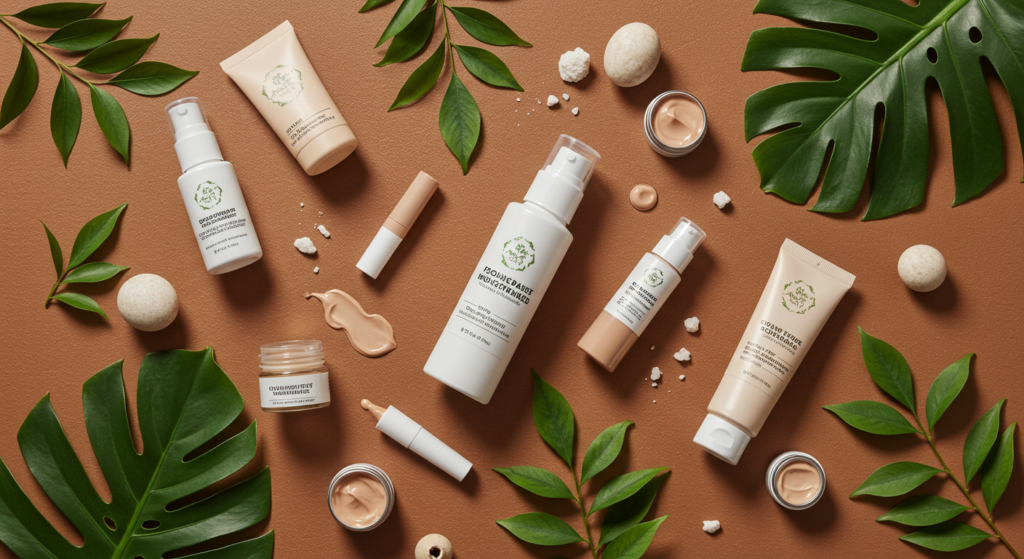
Beauty shouldn’t come at the planet’s expense.
Clean Formulations and Ingredients to Look For
These planet-friendly ingredients deliver results:
- Plant-derived squalane instead of shark-sourced
- Mineral sunscreens that don’t harm coral reefs
- Natural pigments without heavy metals
- Biodegradable preservative systems
- Non-GMO, organically grown botanicals
More brands are pursuing Ecocert or COSMOS certification for verified clean status.
Packaging Innovations: Reducing Beauty Waste
Look for brands prioritizing:
- Refillable packaging systems
- Post-consumer recycled materials
- Glass containers instead of plastic
- Biodegradable or compostable components
- Minimal packaging that eliminates boxes and inserts
Every purchase is a vote for the kind of beauty industry you want to see.
Brands Leading the Eco-Friendly Charge
Support these companies making sustainability central:
- Aether Beauty: Zero-waste packaging commitment
- Kjaer Weis: Luxury refillable metal compacts
- Vapour Beauty: Minimalist packaging and organic ingredients
- Axiology: Plastic-free, multi-use products
- RMS Beauty: Glass packaging and food-grade ingredients
Their tinted moisturizer options prove you don’t need to choose between performance and planetary health.
Summary: Finding Your Perfect Tinted Moisturizer Match

| Skin Type | Best Formula Type | Key Ingredients to Look For | Application Method | Ideal Finish |
|---|---|---|---|---|
| Dry | Cream or oil-based | Hyaluronic acid, glycerin, oils | Fingers or damp sponge | Dewy |
| Oily | Water-based, oil-free | Niacinamide, silica | Brush or dry sponge | Natural matte |
| Combination | Gel-cream hybrid | Balancing ingredients like aloe | Brush for T-zone, fingers elsewhere | Satin |
| Sensitive | Mineral-based, minimal | Zinc oxide, allantoin, oat | Fingers, gentle patting | Natural |
| Mature | Serum-like hydrators | Peptides, antioxidants | Soft brush or fingers | Luminous |
| Acne-prone | Non-comedogenic | Salicylic acid, tea tree | Clean synthetic brush | Natural |
Frequently Asked Questions
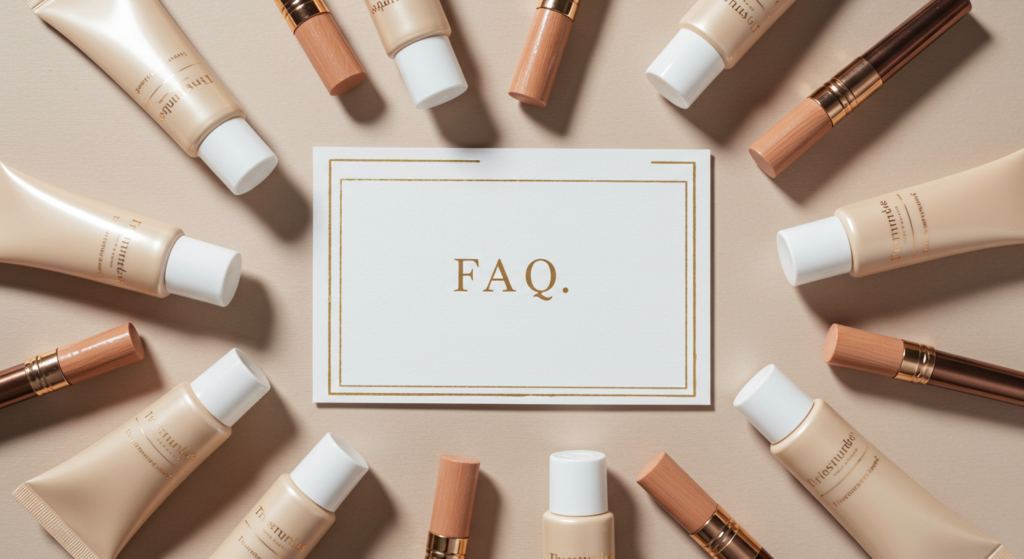
How is tinted moisturizer different from foundation?
Tinted moisturizer prioritizes skincare benefits with sheer coverage, while foundation focuses on coverage with skincare as a secondary benefit. Tinted moisturizers typically contain more hydrating ingredients and less pigment, creating a more natural, skin-like finish.
Can I wear tinted moisturizer if I have oily skin?
Absolutely! Look for oil-free, mattifying formulas specifically designed for oily skin types. These often contain ingredients like silica or clay to absorb excess oil while providing light coverage and necessary hydration.
Do I need to wear sunscreen under my tinted moisturizer with SPF?
Dermatologists typically recommend wearing separate sunscreen under tinted moisturizer, even if it contains SPF. This ensures proper protection since most people don’t apply enough tinted moisturizer to get the full SPF benefit (you would need about a quarter-sized amount for your face).
What’s the best way to match my shade when shopping online?
Research the undertones of available shades and look for comparison swatches from people with similar skin tones. Many brands now offer virtual try-on tools. When in doubt, choose the lighter of two shades—it’s easier to warm up a slightly light shade with bronzer than to make a too-dark shade work.
How long does tinted moisturizer typically last on the skin?
Most tinted moisturizers provide 4-8 hours of wear, depending on skin type, activities, and weather conditions. Oil-control formulas tend to last longer on oily skin, while hydrating formulas perform better on dry skin. Setting strategic areas with powder can extend wear time.
Can tinted moisturizer clog pores or cause breakouts?
Not if you choose the right formula. Look for non-comedogenic or oil-free options if you’re prone to breakouts. Mineral-based formulas tend to be less likely to cause reactions. Always remove tinted moisturizer thoroughly at night to prevent pore congestion.
Is tinted moisturizer appropriate for formal events or photography?
Tinted moisturizer can work for formal events if you choose one with slightly more coverage or build it up in strategic areas. For photography, be aware that SPF can sometimes cause flashback (appearing white in flash photography). If photos are a priority, choose a formula without SPF or set well with powder.
How do I prevent tinted moisturizer from settling into fine lines?
Apply a hydrating primer first, use a light hand when applying product, and avoid setting with heavy powder. A gentle pressing motion with a damp sponge after application can help work the product into the skin rather than sitting on top of lines.
Conclusion
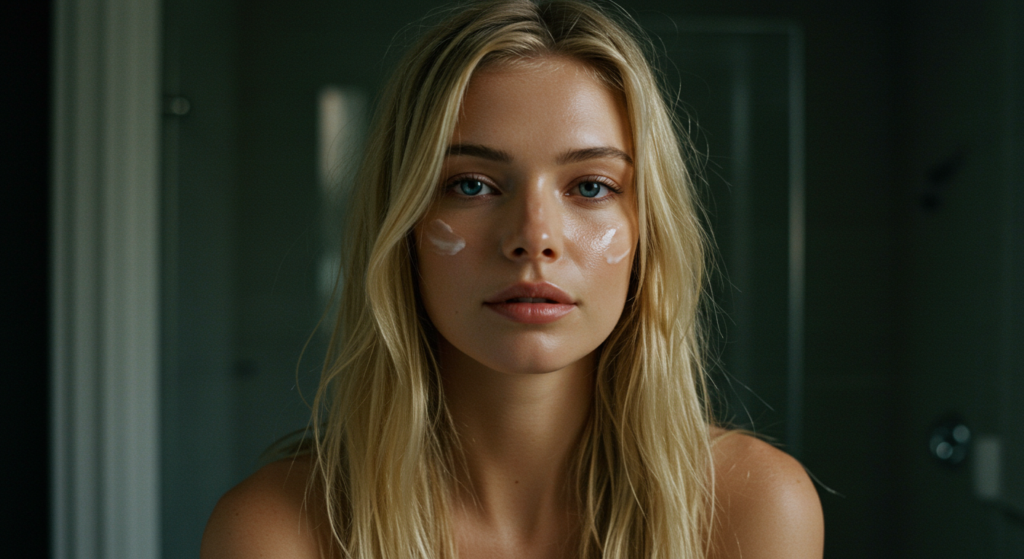
Tinted moisturizers have transformed from a niche beauty item to an essential staple in modern makeup routines, perfectly blending skincare and lightweight coverage.
With formulas tailored for every skin type, age, and concern, achieving that natural, radiant glow has never been easier. Whether you’re simplifying your daily routine, exploring professional application techniques, or choosing sustainable beauty products, there’s a tinted moisturizer designed specifically for your needs.
By selecting the right formula, shade, and application method, you can enhance your skin’s natural beauty effortlessly, making tinted moisturizer an indispensable ally for healthy, luminous skin year-round.
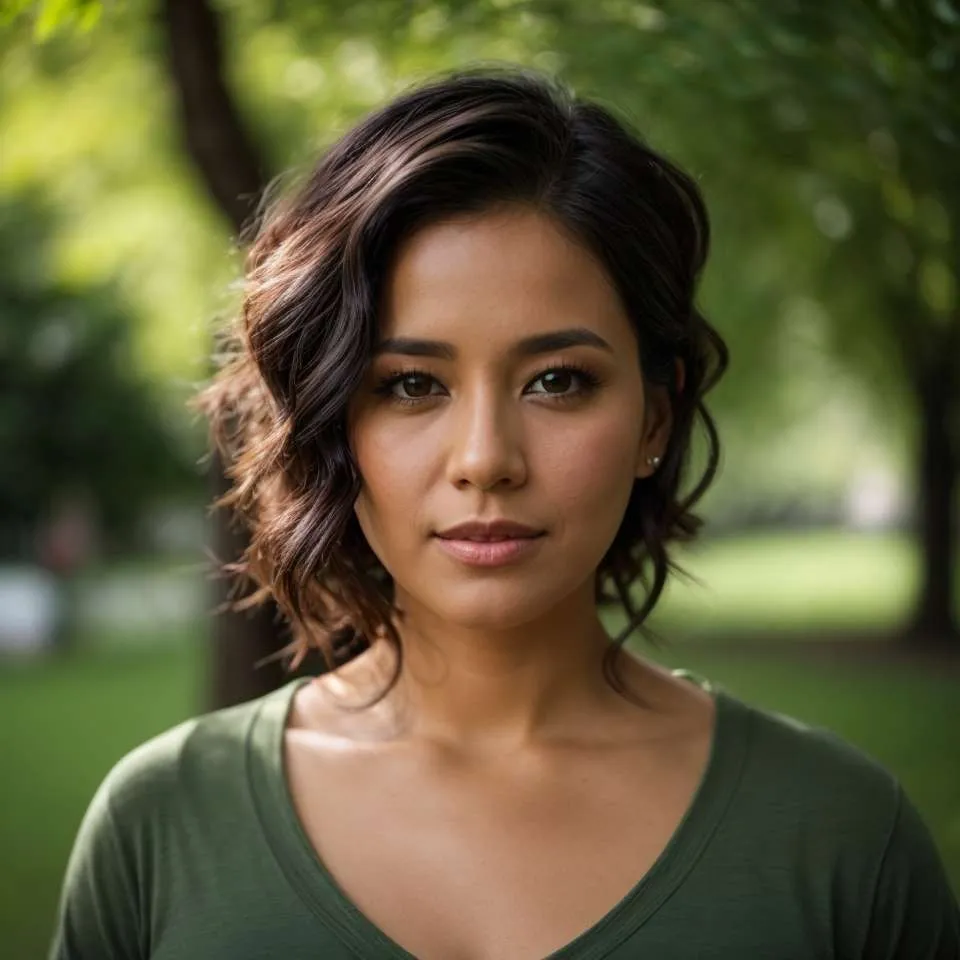
Joanna Perez, with a degree in Creative Writing, excels in recommending distinctive clothing color mixes and trends that deeply connect with readers. She simplifies the often daunting task of color selection, making fashion decisions more personalized and impactful. Her passion for vibrant color palettes and the stories they tell makes her an indispensable voice in the fashion community.
Reviewed By: Marcella Raskin and Anna West
Edited By: Lenny Terra
Fact Checked By: Sam Goldman
Photos Taken or Curated By: Matthew Mansour
